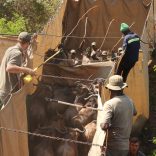Mozambique: Man arrested for trying to sell 12 elephant tusks - Watch
Government decrees orange alert

In file CoM
The Mozambican government on Thursday decreed an “orange alert” because the country is now entering the peak of the 2018-19 rainy season, with risks of flooding on some of the main river basins.
An orange alert is one step down from a red alert, the maximum state of disaster readiness. Under an orange alert, there is partial activation of the Local Disaster Risk Management committee and of the Emergency Operational Centres, and items required for response to extreme weather events are pre-positioned at strategic locations.
Operational response plans are drawn up, and assistance provided to victims of any extreme events.
The rainy season begins in October and runs until the end of March. In the first half of the rainy season, according to the national relief agency, the National Disaster Management Institute (INGC), situations have already occurred which demand monitoring and preventive intervention.
The orange alert was declared in Maputo at a special meeting of the government’s Disaster Management Coordinating Council (CCGC), chaired by Prime Minister Carlos Agostinho do Rosario.
The meeting analysed the current situation along the main river basins, and the long range weather forecast, and was briefed on the activities undertaken so far by the INGC.
Rosario declared that the government needs to anticipate phenomena, and prevent deaths from natural disasters such as drought and floods. “We decided we had to hear what the real situation is, and take preventive measures”, he said.
The government’s main concern at the moment is the southern provinces, where extreme heat is creating drought conditions (despite some days of torrential rain in Maputo). The dry weather across the rural south is leading to food insecurity.
The INGC general director, Augusta Maita, told reporters that declaring an orange alert was declared particularly to allow assistance to the southern region, “but we ended up proposing the alert across the entire region, because there are extreme events elsewhere”.
One such event was an earthquake last Saturday, measuring 5.5 on the Richter scale which shook Mossurize district, in the central province of Manica. It destroyed 108 houses and damaged a further 319 people. Ten people are known to have been injured in the earthquake, which was also felt in Sofala, Inhambane and Gaza provinces.
School and health posts were also damaged. Maita said the INGC is on the ground in Manica, distributing tents and food to families who have lost their homes.
She put the total number of people currently facing food insecurity at 814,567. In November and December, the government and its cooperation partners were able to assist around 328,000 people.
“The institutions are already working to help the population”, said Maita. “We want a little more space in which to intervene. With this alert, we shall have it”.
The INGC has been using its contingency plan to face the situation. That plan envisages expenditure of 206 million meticais (about 3.38 million US dollars). It is nowhere near enough, since the overall needs are put at 1.1 billion meticais.
“This deficit is being reduced by the intervention of our partners”, said Maita.












Leave a Reply
Be the First to Comment!
You must be logged in to post a comment.
You must be logged in to post a comment.